Potential Activity of Recycled Clay Brick in Cement Stabilized Subbase
Abstract
:1. Introduction
2. Material
2.1. Aggregate
2.2. Composition
2.3. Cement
3. Test Scheme
3.1. Specimen Preparation
3.2. Test Methods
3.2.1. Strength Test
3.2.2. Modified EDTA Titration Experiment
4. Test Results and Analysis
4.1. Unconfined Compressive Strength Test
4.2. Modified EDTA titration experiment
4.3. Mechanism Analysis
5. Conclusions
- Component tests of SEM and XRD scanning showed that SiO2 andCaCO3 exist in clay brick as the dominant ingredient.
- When construction waste clay brick is mixed into cement stabilized macadam in the form of aggregate below 4.75mm, there is an optimum content of 50% under the strength standard with the RBA in performance described in this article, and the unconfined compressive strength of 7 d, 28 d, and 90d are 5.46MPa, 7.62MPa, and 9.61MPa respectively, which are greater than the strength of the cement stabilized macadam standard specimen and the values stipulated in specification.
- The titration results of the "modified EDTA titration test" show that 50% of specimens have the lowest content of Ca2+, and the potential activity is maximized in this proportion.
- All the experimental results show that the RBA used in this study has potential activation in cement stabilized structure, and the optimal replace proportion (50%) of RBA in cement stabilized macadam subbase is proven. In this proportion, RBA replaced CBA and enhanced the unconfined compressive strength; at this time, the potential activity is fully stimulated. Appropriate methods exist to digest construction waste in large quantities and solve the problem of funding for the disposal process. According to this blending method and proportion, it can be widely applied in the road structure subbase, which can solve the problems of environmental governance and economic problems.
Author Contributions
Funding
Acknowledgments
Conflicts of Interest
References
- Ten Global Trends for 2019. Available online: https://www.atkearney.com/web/global-business-policy-council/article/?/a/year-ahead-predi (accessed on 12 March 2019).
- Wang, J.Y. Study on the Comprehensive Utilization of Construction Waste in the Process of Urbanization. Wall Mater. Innov. Energy Sav. Build. 2013, 6, 38–41. (In Chinese) [Google Scholar]
- Marzouk, M.; Azab, S. Environmental and economic impact assessment of construction and demolition waste disposal using system dynamics. Resour. Conserv. Recycl. 2014, 82, 41–49. [Google Scholar] [CrossRef]
- Song, Y.Z.; He, Z.Q.; Shen, B.W. The application of the technology of dregs and granule filling in the subgrade construction of expressway. Highway 2016, 61, 86–89. (In Chinese) [Google Scholar]
- Yang, J.P.; Zhang, M.X.; Li, X.B. Application of Recycled Construction Materials in Special Foundation Treatment of Road Engineering. Road Mach. Constr. Mech. 2016, 33, 95–98. (In Chinese) [Google Scholar]
- Li, X.J. Study on the Pavement Structure of Light Traffic Highway in which Construction Waste Used as the Basic Course. Material. Master’s Thesis, Southwest University of Science and Technology, Mianyang, China, 2016. (In Chinese). [Google Scholar]
- Guo, Y.L. Comprehensive comparative analysis of construction waste treatment at home and abroad. Manag. Res. Sci. Technol. Management and Research on Scientific & Technological Achievements. 2015, 11, 28–30. (In Chinese) [Google Scholar]
- Li, Y.; Xu, S.H. Study on the Current Situation of Construction Waste. Constr. Technol. 2007, 36, 480–484. (In Chinese) [Google Scholar]
- Li, N.; Li, X.Z. Learn from the experience in recycling of construction waste in developed countries. Renew. Resour. Circ. Econ. 2009, 6, 41–44. (In Chinese) [Google Scholar]
- Wang, L.C. Study on Legal Regulation of Construction Waste. Master’s Thesis, Huaqiao University, Quanzhou, China, 2017. [Google Scholar]
- Xue, C.Z.; Shen, A.Q.; Guo, Y.C.; Wan, C.G.; Zhang, J. Impact of Construction Waste Composite Powder Material on Concrete Anti-frost Performance. Mater. Rev. 2014, 30, 121–125. (In Chinese) [Google Scholar]
- Zhu, P.; Mao, X.Q.; Qu, W.J.; Li, Z.Y.; Ma, Z.G. Investigation of using recycled powder from waste of clay bricks and cement solids in reactive powder concrete. Constr. Build. Mater. 2016, 113, 246–254. (In Chinese) [Google Scholar] [CrossRef]
- Cheng, H.L. Experimental study on recycled concrete of fly ash and waste clay brick. Concr. Cem. Prod. 2005, 5, 48–50. (In Chinese) [Google Scholar]
- Khalaf; Fouad, M. Using Crushed Clay Brick as Coarse Aggregate in Concrete. J. Mater. Civ. Eng. 2006, 18, 518–526. [Google Scholar] [CrossRef]
- Fořtová, K.; Pavluring, T. The Performances of Fine Recycled Aggregate Concrete Containing Recycled Bricks from Construction and Demolition Waste. Key Eng. Mater. 2018, 760, 193–198. [Google Scholar] [CrossRef]
- Xiao, Z.; Ling, T.C.; Kou, S.C.; Wang, Q.; Poon, C.S. Use of wastes derived from earthquakes for the production of concrete masonry partition wall blocks. Waste Manag. 2011, 31, 1859–1866. [Google Scholar] [CrossRef] [PubMed]
- Hu, L.Q.; Sha, A.M. Performance Test of Cement Stabilized Crushed Clay Brick for Road Base Material. China J. Highw. Transp. 2012, 3, 73–79. (In Chinese) [Google Scholar]
- Turanli, L.; Bektas, F.; Monteiro, P.J.M. Use of ground clay brick as a pozzolanic material to reduce the alkali–silica reaction. Cem. Concr. Res. 2003, 33, 1539–1542. [Google Scholar] [CrossRef]
- Peng, C.J. Study on Performances of Recycled Coarse Aggregate Asphalt Concrete. Master’s Thesis, South China University of Technology, Guangzhou, China, 2017. (In Chinese). [Google Scholar]
- Li, L.H.; Zhang, N.L. Road Building Materials, 1st ed.; Tongji University Press: Shanghai, China, 1999; pp. 18–23. (In Chinese) [Google Scholar]
- Hu, S.G. Advanced Cement-based Composites; Science Publishing & Media Ltd.: Beijing, China, 2017; pp. 81–85. [Google Scholar]
- Pu, X.C.; Wang, Y.W. High-performance active mineral admixtures and concrete. Concrete 2002, 2, 3–7. (In Chinese) [Google Scholar]
- Pu, X.C.; Wang, Y.W. High-performance active mineral admixtures and concrete (continued). Concrete 2002, 3, 21–24. (In Chinese) [Google Scholar]
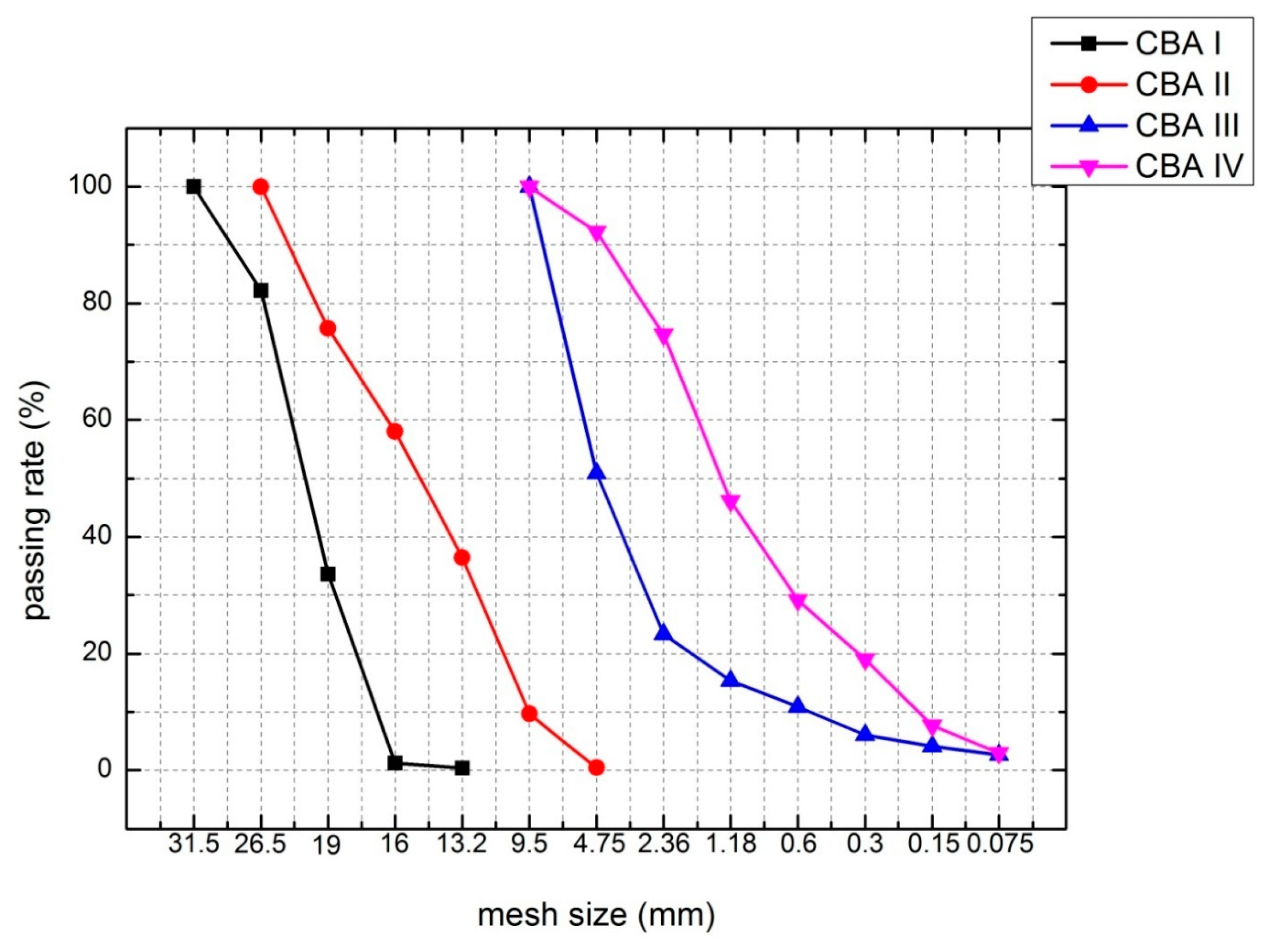
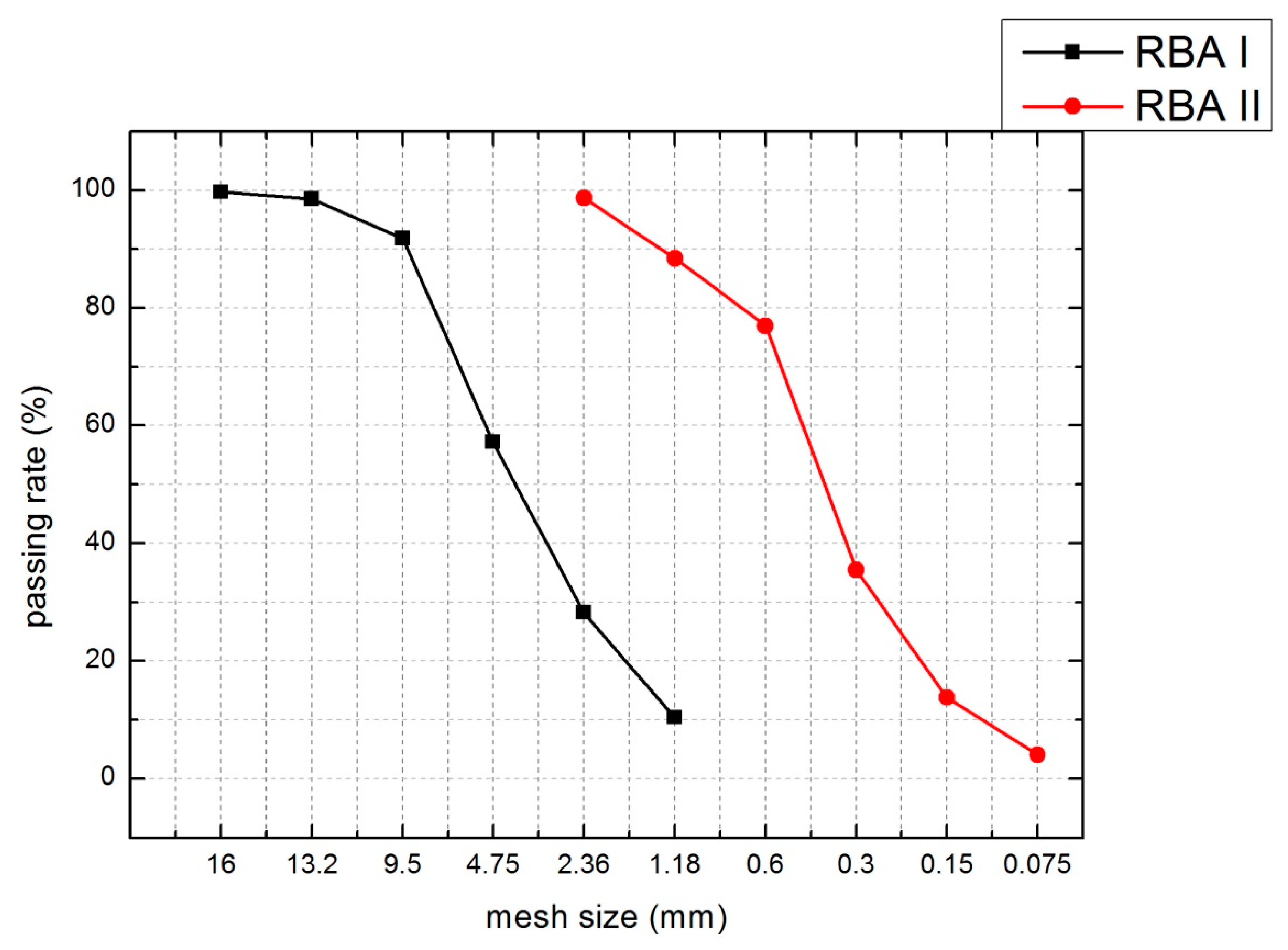
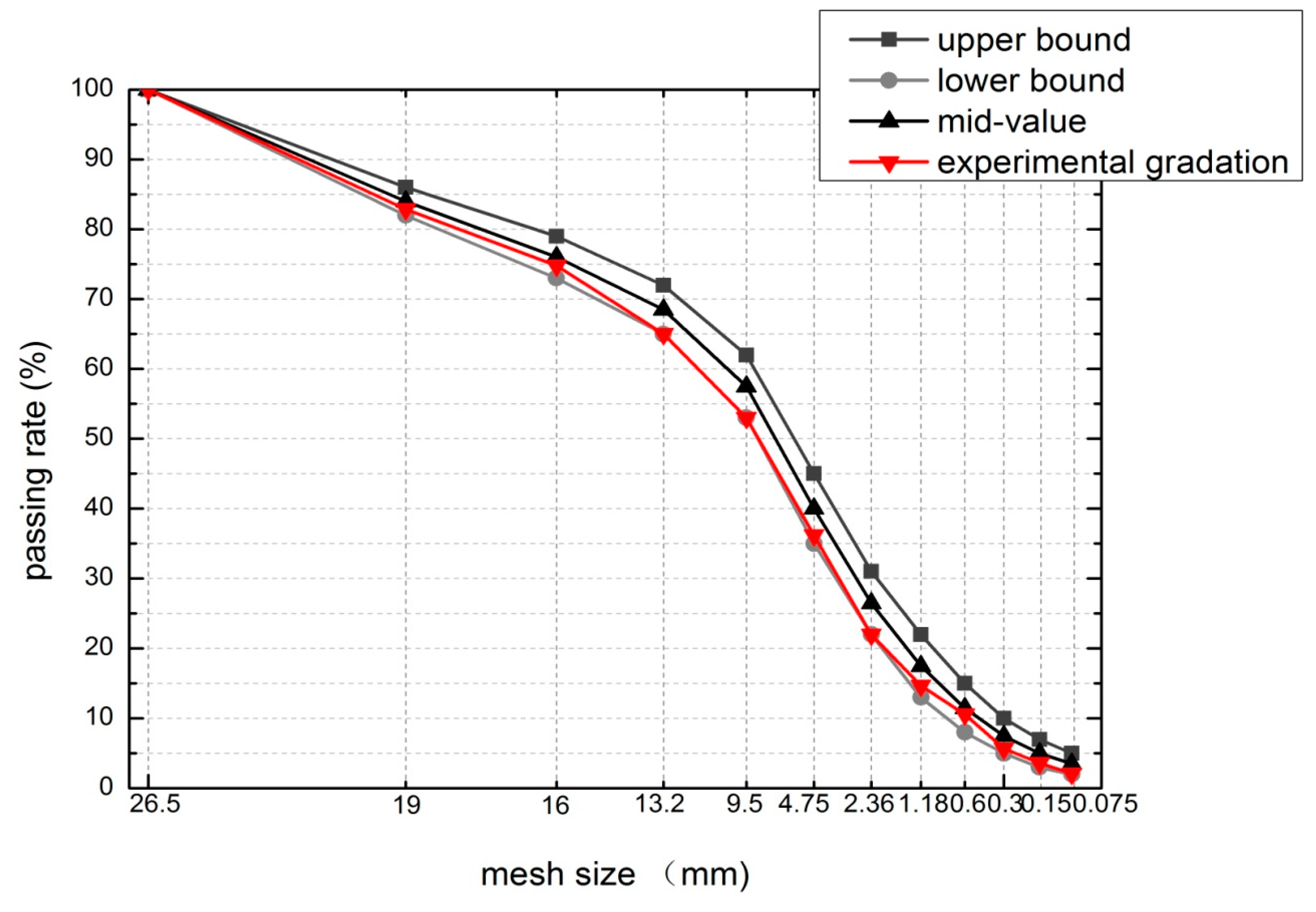
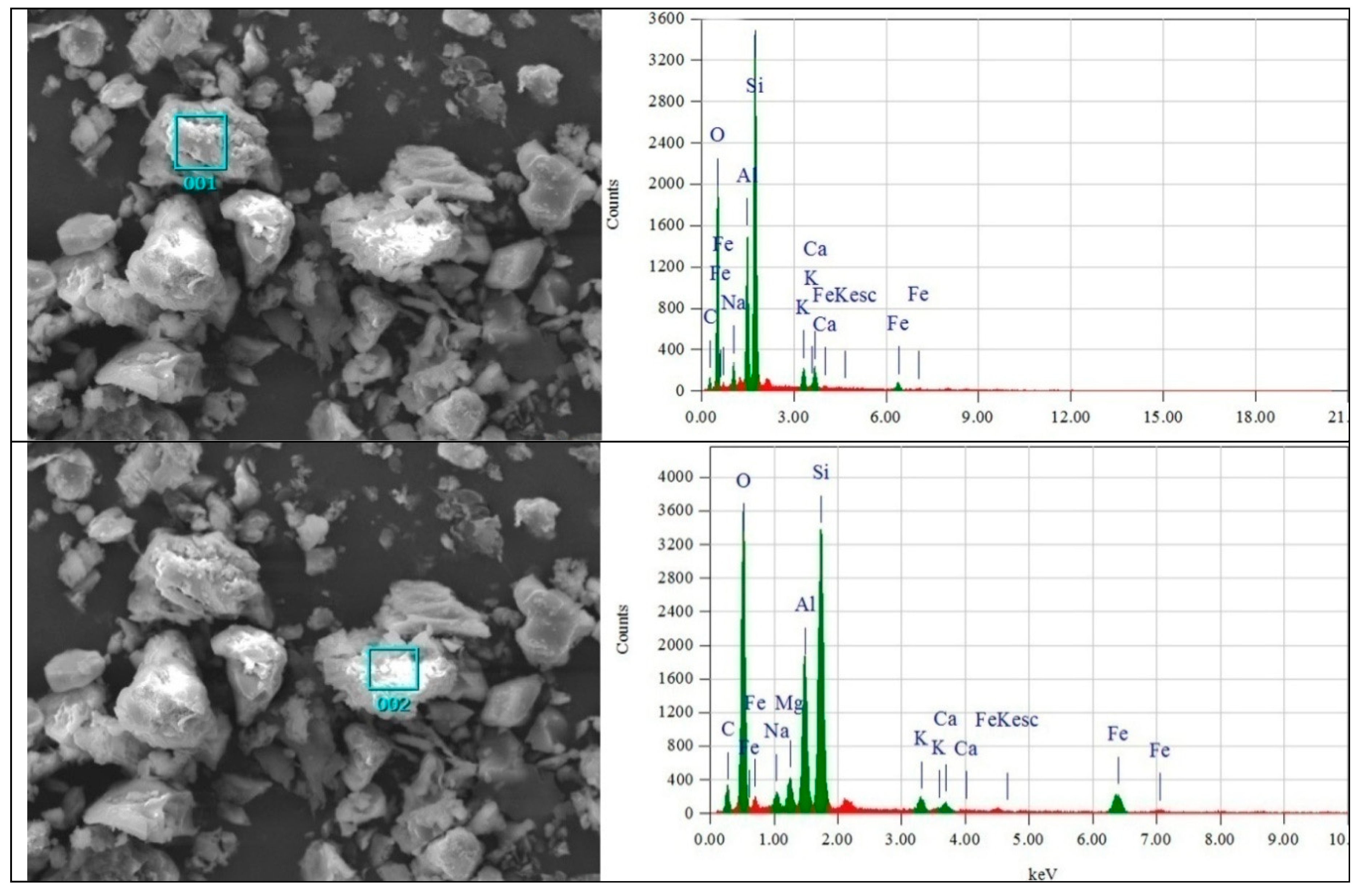
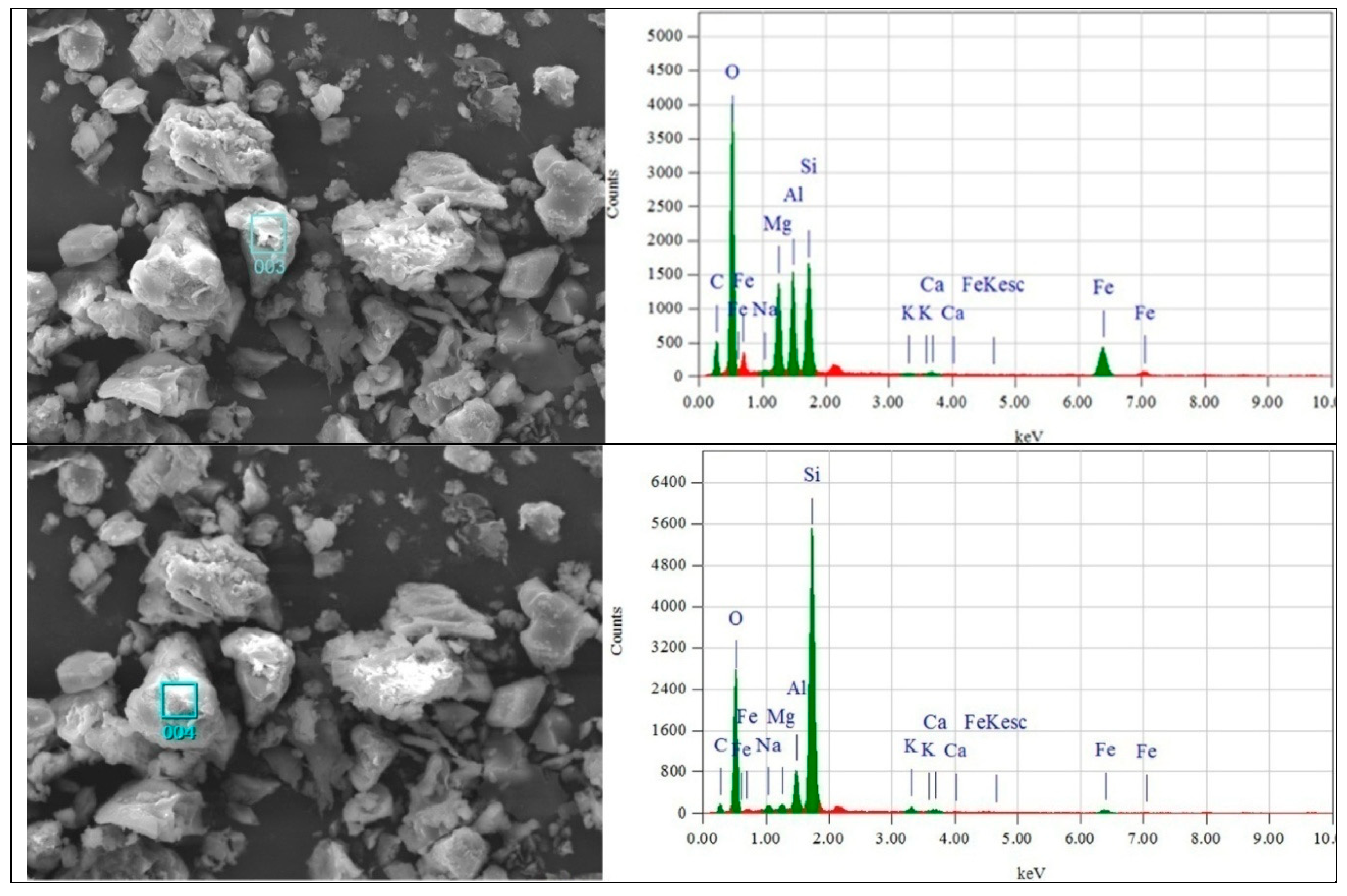
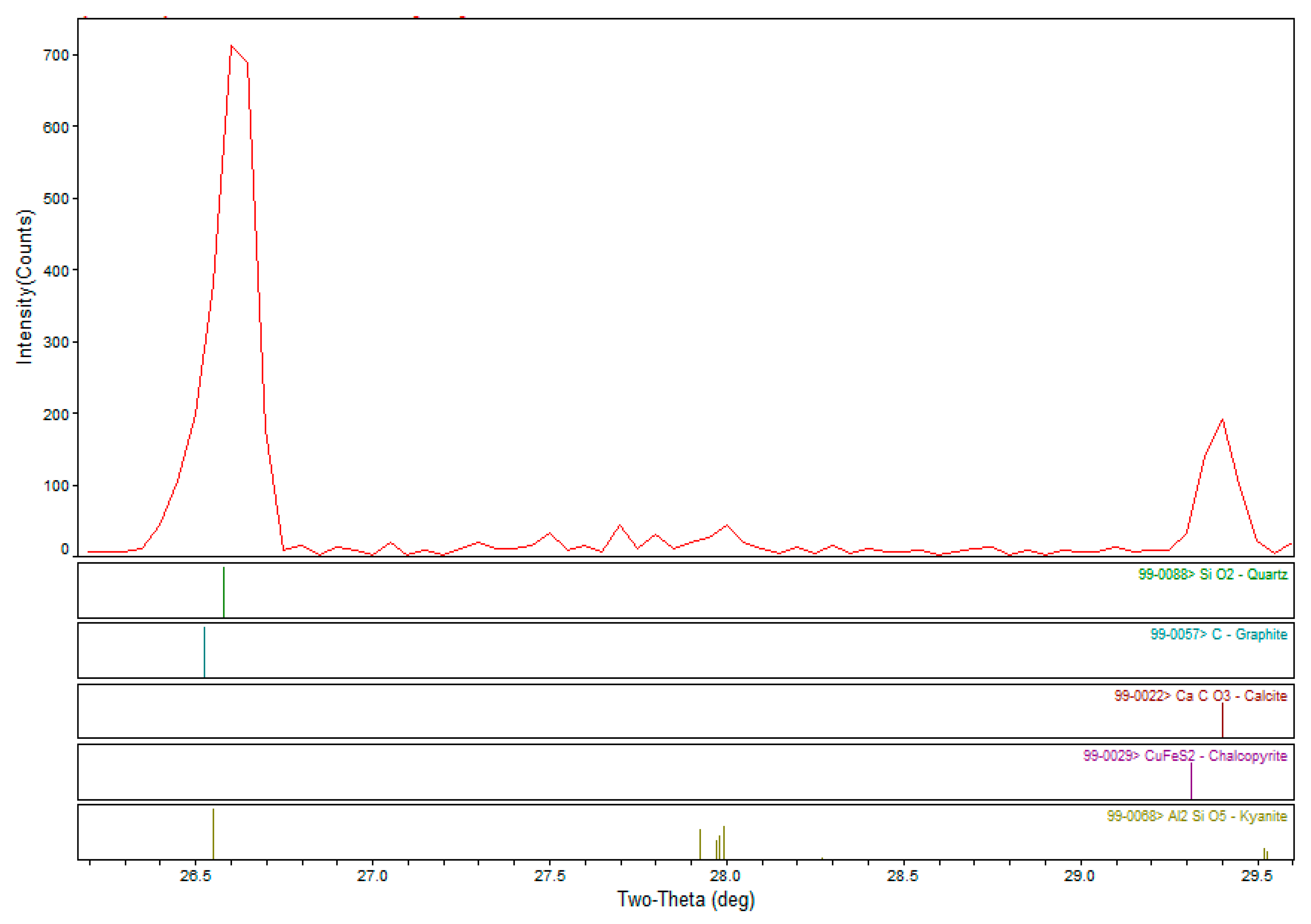
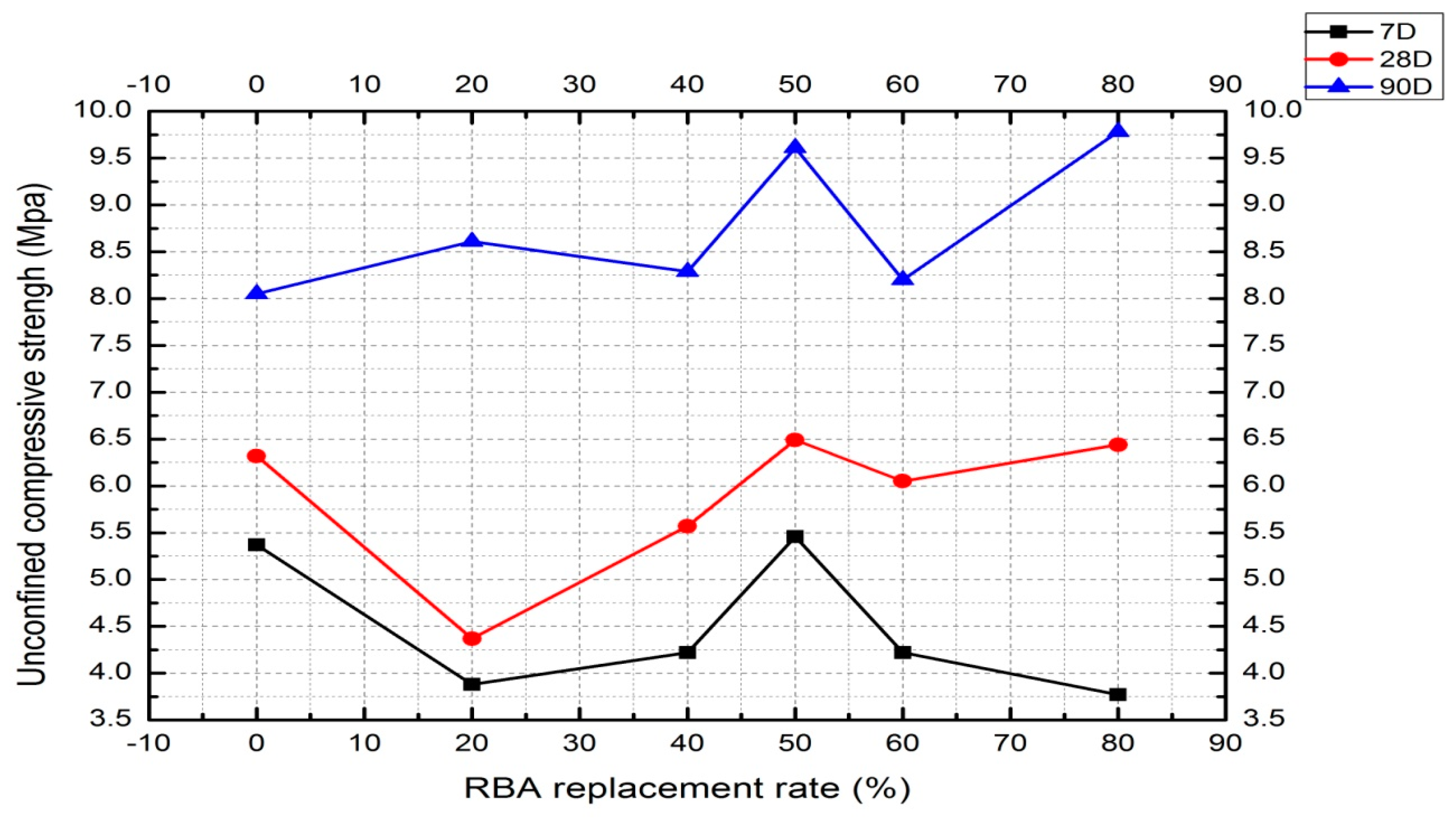
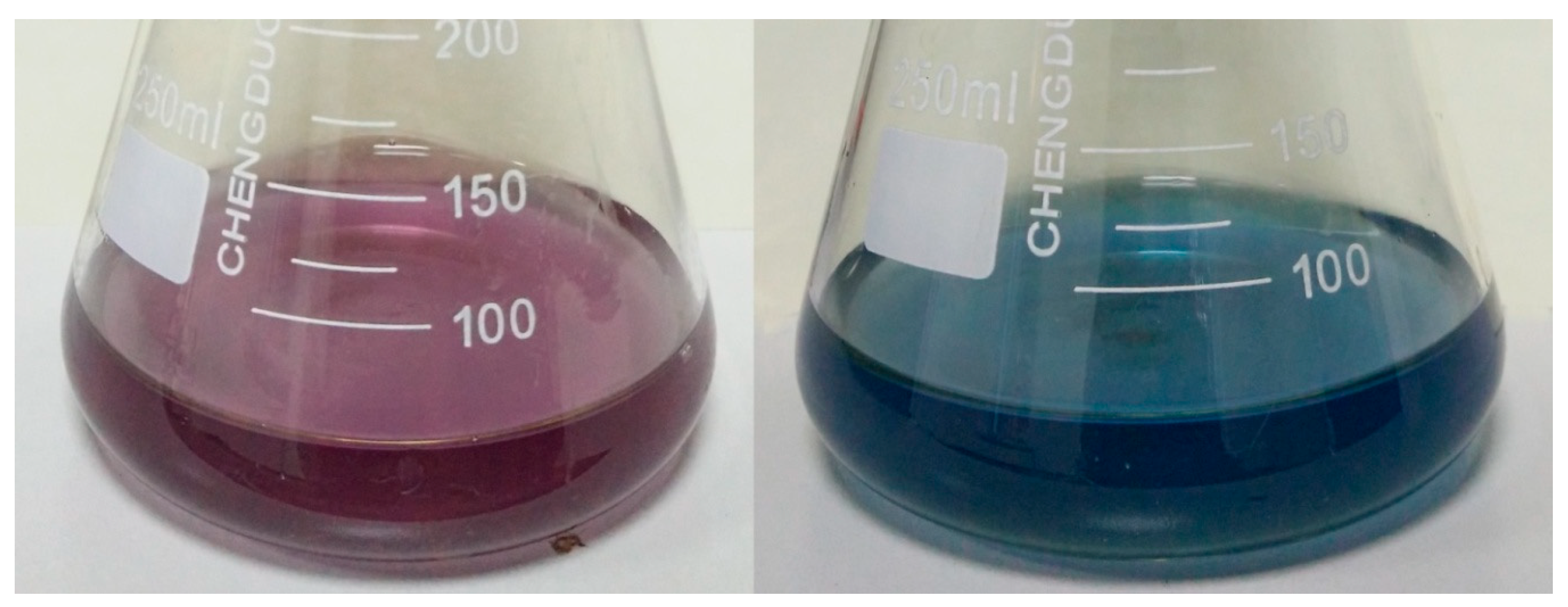
| Fine Aggregate | Coarse Aggregate | ||||||
|---|---|---|---|---|---|---|---|
| Plastic Index | Water Absorption (%) | Apparent Specific Gravity | Crushed Stone Value (%) | Flat-Elongated Particle (%) | Water Absorption (%) | Apparent Specific Gravity | |
| 0% a | 4.34 | 1.73 | 2.68 | 21.63 | 9.57 | 1.24 | 2.73 |
| 20% a | 6.16 | 3.89 | 2.59 | 22.85 | 9.53 | 3.75 | 2.69 |
| 40% a | 9.84 | 8.21 | 2.50 | 25.74 | 9.72 | 7.42 | 2.58 |
| 50% a | 13.97 | 10.32 | 2.41 | 28.45 | 9.89 | 9.98 | 2.51 |
| 60% a | 24.53 | 13.02 | 2.33 | 31.22 | 9.59 | 11.86 | 2.45 |
| 80% a | 40.64 | 15.53 | 2.24 | 38.41 | 9.63 | 14.97 | 2.39 |
| 100% a | 60.50 | 17.60 | 2.11 | 41.53 | 9.97 | 17.36 | 2.33 |
| Reference value | ≤12 | —— | —— | ≤30 | —— | —— | —— |
| Element | Mass (%) | Atom (%) | Sigma | Energy (keV) |
|---|---|---|---|---|
| C(Graphite) | 16.69 | 24.57 | 0.19 | 0.277 |
| O | 49.08 | 54.60 | 0.29 | 0.525 |
| Na | 1.16 | 0.91 | 0.05 | 1.041 |
| Mg | 2.97 | 2.11 | 0.05 | 1.253 |
| Al | 6.53 | 4.33 | 0.08 | 1.486 |
| Si | 18.75 | 12.02 | 0.13 | 1.739 |
| K | 0.96 | 0.45 | 0.04 | 3.312 |
| Ca | 0.75 | 0.35 | 0.03 | 3.690 |
| Fe | 3.86 | 1.21 | 0.09 | 6.398 |
| Type | Comparison | Physical Performances | |||||
|---|---|---|---|---|---|---|---|
| Setting Time (h) | Strength (MPa) | ||||||
| Flexural Strength | Unconfined Compressive Strength | ||||||
| Initial set | Final set | 3d | 28d | 3d | 28d | ||
| P.O 42.5R | Reference Value | ≥0.75 | ≤10 | ≥4.0 | ≥6.5 | ≥21.0 | ≥42.5 |
| Test result | 2 | 3 | 5.2 | 8.5 | 25.0 | 53.0 | |
| RBA Replacement Rate (%) | 0 | 20 | 40 | 50 | 60 | 80 |
|---|---|---|---|---|---|---|
| Maximum density (g·cm−³) | 2.362 | 2.215 | 2.167 | 2.143 | 2.122 | 2.152 |
| Optimum moisture content (%) | 5.11 | 6.87 | 7.04 | 7.35 | 8.17 | 8.31 |
| RBA Replacement Rate (%) | 0 | 20 | 40 | 50 | 60 | 80 |
|---|---|---|---|---|---|---|
| 7d UCS (MPa) | 5.37 | 3.88 | 4.22 | 5.46 | 4.22 | 3.77 |
| 28d UCS (MPa) | 7.07 | 5.77 | 7.08 | 7.62 | 7.09 | 6.51 |
| 90d UCS (MPa) | 8.05 | 8.61 | 8.29 | 9.61 | 8.20 | 9.78 |
| 7–28d UCSIV (MPa) | 1.70 | 1.89 | 3.19 | 2.16 | 2.87 | 2.74 |
| 7–90d UCSIV (MPa) | 2.68 | 4.73 | 4.07 | 4.15 | 3.98 | 6.01 |
| 7–28d UCSIP (%) | 31.66 | 48.71 | 67.77 | 39.56 | 68.01 | 72.70 |
| 7–90d UCSIP (%) | 49.91 | 121.91 | 96.45 | 76.01 | 94.31 | 159.42 |
| Replacement Rate (%) | 0 | 20 | 40 | 50 | 60 | 80 |
|---|---|---|---|---|---|---|
| EDTA-2Na standard solution consumption ΔV (mL) | 6.05 | 4.15 | 3.20 | 2.35 | 2.40 | 2.55 |
© 2019 by the authors. Licensee MDPI, Basel, Switzerland. This article is an open access article distributed under the terms and conditions of the Creative Commons Attribution (CC BY) license (http://creativecommons.org/licenses/by/4.0/).
Share and Cite
Liang, C.; Wang, Y.; Song, W.; Tan, G.; Li, Y.; Guo, Y. Potential Activity of Recycled Clay Brick in Cement Stabilized Subbase. Appl. Sci. 2019, 9, 5208. https://doi.org/10.3390/app9235208
Liang C, Wang Y, Song W, Tan G, Li Y, Guo Y. Potential Activity of Recycled Clay Brick in Cement Stabilized Subbase. Applied Sciences. 2019; 9(23):5208. https://doi.org/10.3390/app9235208
Chicago/Turabian StyleLiang, Chunyu, Ying Wang, Wenzhu Song, Guojin Tan, Yanling Li, and Youmeng Guo. 2019. "Potential Activity of Recycled Clay Brick in Cement Stabilized Subbase" Applied Sciences 9, no. 23: 5208. https://doi.org/10.3390/app9235208
APA StyleLiang, C., Wang, Y., Song, W., Tan, G., Li, Y., & Guo, Y. (2019). Potential Activity of Recycled Clay Brick in Cement Stabilized Subbase. Applied Sciences, 9(23), 5208. https://doi.org/10.3390/app9235208






